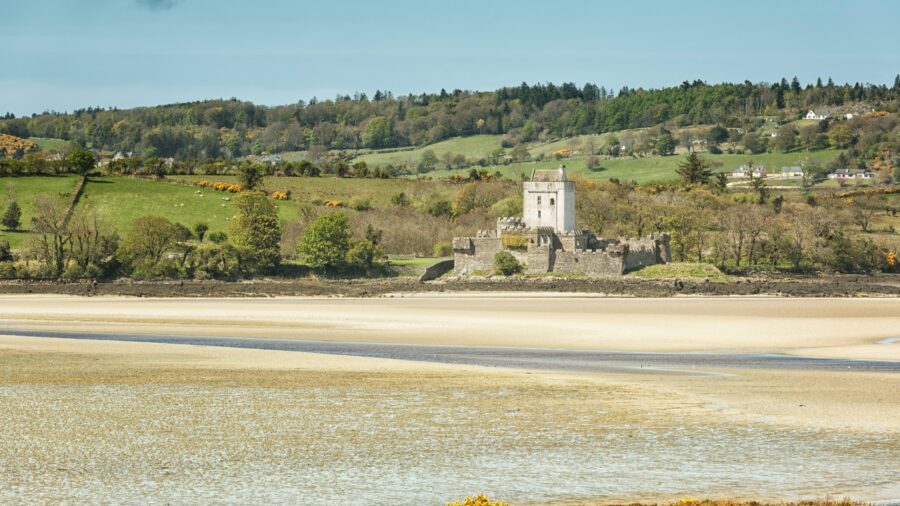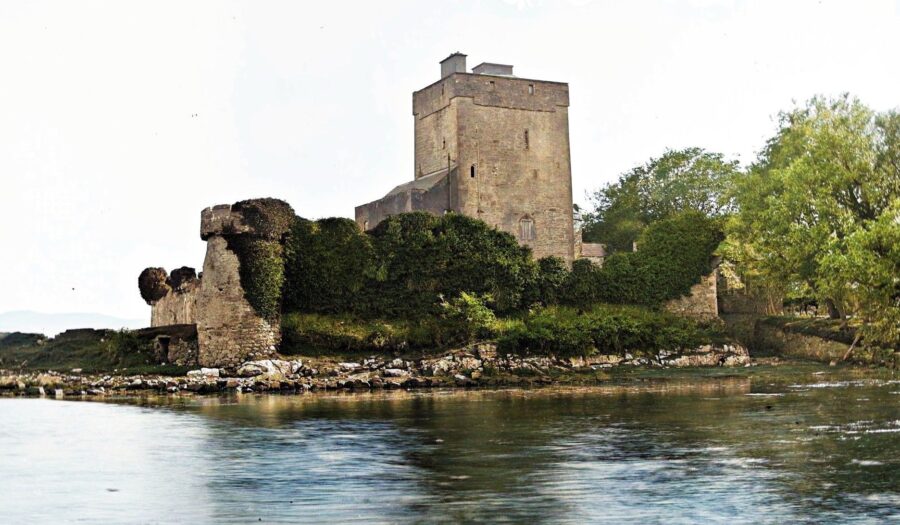Doe Castle, Co. Donegal
Doe Castle, Co. Donegal
Doe Castle, or Caisleán na dTuath, stands majestically on a small peninsula jutting into Sheephaven Bay in County Donegal, Ireland. Renowned for its strategic location, surrounded on three sides by water with a protective moat cut into the rock on the landward side, Doe Castle has been a witness to numerous historical events and transitions. Initially built as a stronghold of the Clan Suibhne, known as the MacSweeneys, who were of Norse-Gaelic origin, the castle’s architecture bears resemblances to Scottish tower houses, indicative of the cultural and historical connections across the North Channel. Over the centuries, Doe Castle has seen various phases of conflict and peace, making it a significant site for understanding the historical landscape of the region.
Contents
Early History
Doe Castle, or Caisleán na dTuath, was first constructed in the early 15th century, around 1420, although its exact origins are slightly obscured by time. The castle is strategically situated on a small peninsula in Sheephaven Bay, County Donegal, leveraging natural defenses provided by the surrounding waters. This initial placement was instrumental, suggesting a purpose-built facility for defense and control over the local area.
The castle is notably linked with the MacSweeney clan, a family of Scottish origin who were part of the gallowglass—mercenary warriors from Scotland esteemed for their military skills. The MacSweeneys settled in Ireland, and by the 1440s, they had come into possession of Doe Castle. As a gallowglass stronghold, the castle became a crucial military and administrative center. The MacSweeneys, known as MacSuibhne na dTuath (MacSweeney of the Territories), used it not only as a defensive structure but also as a base from which to exert influence and control over their lands in North-West Ireland.
Ownership Changes and Military Role
The 17th century brought significant changes in the ownership and role of Doe Castle, reflective of the broader political and military upheavals in Ireland during that period. In the early 1600s, the castle was seized by King James VI and I as part of the Crown’s efforts to quell Gaelic resistance and reassert control over Ireland. This seizure was a direct consequence of the rebellion by the native Irish lords against English rule.
In 1613, following the Plantation of Ulster—an event that saw the confiscation of Irish lands and their redistribution to British settlers—the castle was granted to Sir John Davies, the Attorney-General for Ireland. This marked the beginning of the castle’s transition from a Gaelic stronghold to an asset controlled by the English Crown.
The castle’s military significance continued to evolve, especially noted during the Irish Confederate Wars. In 1642, Owen Roe O’Neill, a figure of immense historical importance, used Doe Castle as his base after returning from continental Europe to lead the Ulster Army against the English. O’Neill’s choice of Doe Castle as a headquarters underscores its strategic importance and the role it played in the nationalistic and military endeavors of the Irish during the 17th century.
Throughout this period, Doe Castle was a focal point in the ongoing struggle for control between the Irish and the English, changing hands multiple times. Each change in ownership at Doe Castle not only reflected the immediate military fortunes of those involved but also mirrored the larger contest for sovereignty and control in Ireland.
This dynamic history of ownership and military relevance highlights Doe Castle’s pivotal role in the political and military history of Ireland, serving as both a bastion of Gaelic resistance and a symbol of the imposition of new political orders throughout its extensive past.
Ownership through the Ages
Doe Castle changed hands multiple times through the centuries. Here is a chronological list of its known owners:
- O’Donnell Family – The castle was most likely built around 1420 by the O’Donnell family, a prominent Gaelic clan in Ulster.
- MacSweeney Clan – By the 1440s, Doe Castle came into the possession of the MacSweeney family, specifically a branch known as MacSuibhne na dTuath (MacSweeney of the Territories). They were a notable family of gallowglass mercenaries of Scottish origin.
- English Crown – In the early 17th century, the castle was seized by King James VI and I following the rebellion by the Gaelic lords. This was part of the effort to suppress Irish resistance and enforce English control.
- Sir John Davies – Granted the castle in 1613 during the Plantation of Ulster. Davies was the Attorney-General for Ireland at the time.
- Captain John Sandford – In 1614, Sir John Davies sold Doe Castle to Captain John Sandford from Shropshire, England.
- Sir Charles Coote – Took possession of the castle around 1650 during the Cromwellian conquest of Ireland.
- Sir George Vaughan Hart – By the late 18th century and into the 19th century, the castle was in the hands of Sir George Vaughan Hart, who undertook various renovations.
- Land Commission and the Irish Government – In 1932, the castle was acquired by the Land Commission and later vested as a national monument, under the care of the Office of Public Works from 1934 onwards.
Architectural Features
Doe Castle, renowned for its distinctive architectural features, encapsulates a rich history through its robust and strategic design. The castle is structured around a central tower house, which is encircled by a defensive bawn wall, and includes a strategically significant moat that adds to its fortification.
Tower House
The heart of Doe Castle is its tower house, a four-storey structure typical of the Scottish influence on Irish coastal fortifications. Each floor within the tower was designed for specific functions: the ground floor often served storage purposes, the first floor housed the great hall where the lord conducted business and entertained guests, and the upper floors contained private family quarters and guest rooms. The tower’s thick stone walls, approximately 8 feet in depth, not only provided formidable defense against attacks but also regulated the internal temperature, keeping it warm in winter and cool in summer.
Bawn Wall
Surrounding the tower house is the bawn, a high-walled courtyard that provided a first line of defense and a controlled environment for daily activities within the castle grounds. These bawn walls were equipped with flankers at the corners, enhancing the castle’s defensive capabilities by allowing guards to observe and engage assailants from protected positions. The walls featured gun loops and arrow slits, through which defenders could fire upon attackers without exposing themselves to return fire.
Moat
Perhaps one of the most distinctive features of Doe Castle is its moat. Unlike the typical water-filled moats that surround many medieval castles, Doe Castle’s moat is cut directly into the bedrock on the landward side, creating a formidable barrier that discouraged and impeded the approach of hostile forces. This moat not only served a defensive purpose but also delineated the controlled space of the castle, reinforcing its presence and authority in the landscape.
Defensive Strategy
The strategic location of Doe Castle, on a peninsula surrounded on three sides by water, maximizes natural defensive advantages. The only accessible approach is from the landward side, heavily fortified by the moat and the bawn walls. This geographical positioning made the castle a stronghold that was difficult to besiege and easy to defend.
Additional Features
Over the centuries, various modifications were made to enhance the castle’s residential and defensive capabilities. The inclusion of a barbican and additional round towers in the bawn during renovations in the 19th century reflected the evolving military strategies and the continued importance of the castle as a fortified residence.
Restorations and Modern Era
20th Century Restoration Efforts
Doe Castle, having withstood the tests of time and conflict, underwent significant restoration efforts in the 20th century to preserve its historical integrity and structural stability. The Office of Public Works (OPW) in Ireland took charge of these efforts after the castle was declared a national monument in 1934. The major restoration work began in the 1990s, focusing on refurbishing the tower house and repairing the bawn walls, which had suffered from centuries of exposure to the harsh coastal weather.
These restorations were meticulously carried out to ensure that the castle’s medieval character was retained while making it safe and accessible for public visits. Techniques and materials compatible with the original construction were used to preserve the castle’s authenticity, aesthetic, and historical value. The restoration involved stabilizing the structure, replacing eroded stonework, and installing safety features without compromising the castle’s ancient appearance.
Current Status as a National Monument and Tourist Attraction
Today, Doe Castle stands as a proud symbol of Ireland’s rich cultural heritage, managed by the Office of Public Works. It is designated as a national monument, highlighting its importance and ensuring continued protection and maintenance. This status not only recognizes the castle’s historical and architectural significance but also its role in the cultural narrative of Ireland.
As a tourist attraction, Doe Castle attracts visitors from around the world, drawn by its picturesque location on Sheephaven Bay and its compelling history. The castle grounds are open to the public daily, with guided tours available during the summer months. These tours offer insights into the life of the Gaelic chieftains, the strategic military role of the castle, and the architectural features that have been preserved through centuries.
The visitor experience is enhanced by informational panels installed around the castle, providing a detailed chronicle of its history from its establishment in the 15th century to its current status. The old graveyard adjacent to the castle, where members of the MacSweeney clan are buried, adds a poignant touch to the visit, connecting the past with the present.

Cultural Significance
Doe Castle holds a prominent place in Irish cultural history, not only as a military stronghold but also as a beacon of Gaelic heritage and folklore. Over the centuries, it has been the setting for numerous historical events and tales that resonate deeply with the local community and visitors alike.
Historical Events
The castle’s history is intertwined with that of the MacSweeney clan, notable for their role as gallowglass mercenaries from Scotland, which underscores the cultural and martial exchanges between Scotland and Ireland during the medieval period. This connection is highlighted by the architectural style of the castle, which shares similarities with Scottish tower houses. Additionally, the castle’s strategic importance was demonstrated during the 17th century when it served as a headquarters for Owen Roe O’Neill during the Irish Confederate Wars, further cementing its place in Irish military history.
Folklore and Legends
Doe Castle is steeped in local folklore, adding a layer of mystique and appeal. One of the most poignant tales is that of the tragic love story between a young chieftain of the O’Boyle family and Eileen MacSweeney, daughter of the MacSweeney chieftain. According to legend, their forbidden love led to heartbreaking consequences, with Eileen jumping to her death from the castle tower upon seeing her lover slain. This story, while likely apocryphal, is often recounted in local lore and adds a romantic and tragic dimension to the historical narrative of the castle.
Cultural References
The castle has also been a muse for poets and artists, featuring in ballads and paintings that depict its rugged beauty and dramatic history. These cultural artifacts continue to draw attention to the castle, enriching the visitor experience by connecting them with the artistic and literary heritage of the region.
Modern Cultural Role
Today, Doe Castle is not only a historical monument but also a venue for cultural events, including local festivals and gatherings that celebrate Irish history and tradition. These events help keep the community’s heritage alive, engaging with both locals and tourists in a meaningful dialogue about the past.
Educational Value
Doe Castle serves as an educational resource, offering insights into the Gaelic clan system, architectural styles of the period, and the broader historical context of Ireland’s tumultuous past. The castle’s preservation allows for a tangible exploration of these themes, making it a valuable tool for both formal and informal learning.
In summary, Doe Castle embodies a rich tapestry of history, folklore, and cultural memory, making it a key site for understanding and appreciating the depth of Ireland’s historical and cultural landscape.
Visiting Doe Castle
Doe Castle, with its rich history and picturesque setting on Sheephaven Bay, offers a memorable experience for visitors interested in Irish history and architecture. Here’s what you need to know when planning a visit:
Access and Opening Hours
Doe Castle is located near the village of Creeslough in County Donegal, easily accessible via the R245. The castle grounds are open to the public daily, with specific hours varying by season. It’s advisable to check the latest opening times and any potential restrictions or closures on the Office of Public Works website or by contacting local tourist information centers.
Guided Tours
Guided tours of Doe Castle are available during the summer months, typically from June through August. These tours are highly recommended as they provide insightful narratives not only about the castle’s architectural features but also about its historical significance and the tales that have shaped its legacy. The guides, often locals knowledgeable about the region’s history, bring the past to life with stories of the castle’s former inhabitants and their roles in Irish history.
Accessibility
Efforts have been made to make Doe Castle accessible to a wide range of visitors. However, due to its historical structure and natural surroundings, some areas might be challenging for those with limited mobility. The ground floor of the tower house is accessible, but the upper floors may only be reached via narrow staircases. The outdoor areas are mostly grassy and can be uneven, so appropriate footwear is recommended.
Facilities and Regulations
Visitor facilities include parking areas close to the site and informational signage that offers context about the visible structures and their historical contexts. Photography is allowed.
Local Attractions
Visiting Doe Castle can be part of a broader exploration of County Donegal. The castle is situated on the scenic Wild Atlantic Way, making it an excellent inclusion in a driving route along this stunning coastal path. Nearby attractions include the beautiful beaches of Dunfanaghy and the rugged landscapes of Glenveagh National Park, which offers additional historical sites, walking trails, and the opportunity to see local wildlife.
Cultural Events
During the summer, Doe Castle occasionally hosts cultural events such as local music performances and historical reenactments, which can enhance the visitor experience. Checking local event schedules when planning your visit might provide a unique opportunity to see the castle come to life as it might have been in the past.

Did you find this helpful?
IrishHistory.com is a website that relies on community contributions to help make it better. If you have a suggestion to improve this page, or have spotted any errors, please click ‘Suggest an Edit’
